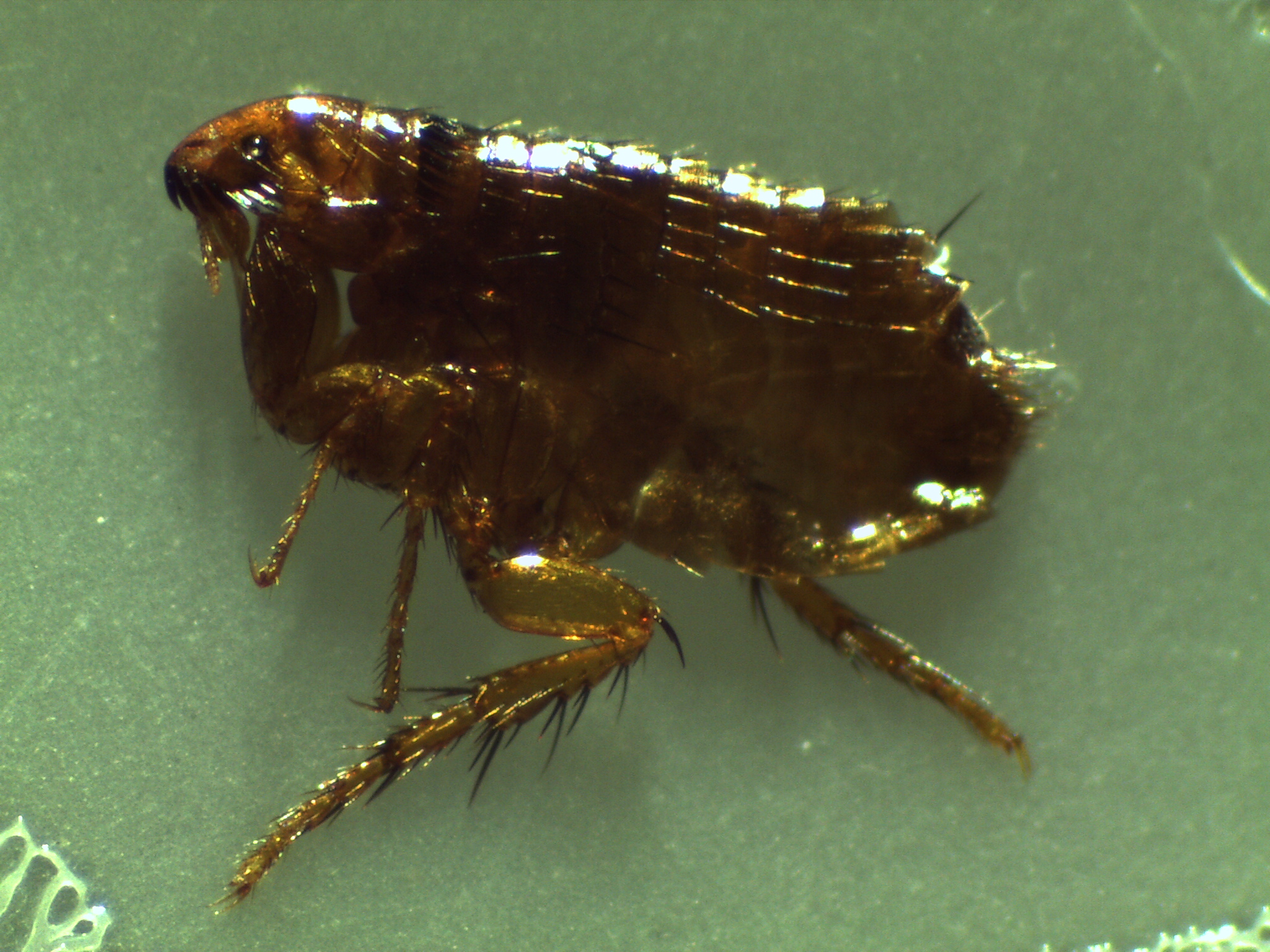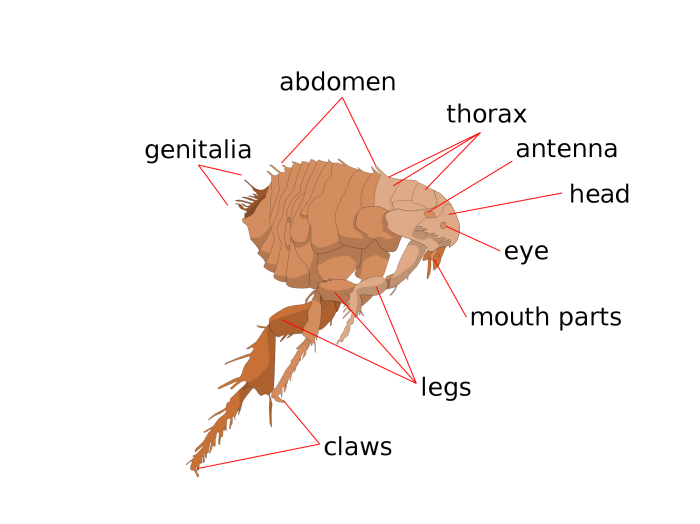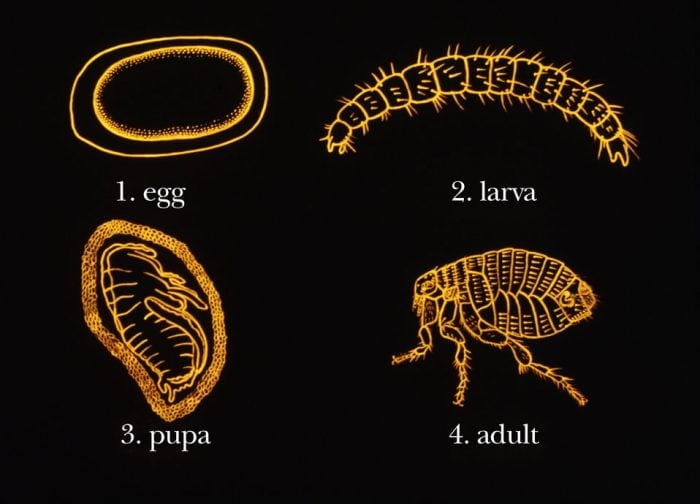
Fleas are generally 1.5-3.3mm in length and are usually a dark reddish brown color. Like all insects, they have a segmented body with a head abdomen and thorax with 6 legs in total. At the end of each leg are long claws meant for grasping surfaces. They also utilize a proboscis to pierce the skin and drink blood.
The term “flea” actually refers to a large variety of species of flightless insects in the order Siphonaptera. There are over 2,500 known species of flea that exist all over the world in a number of environments. Fleas are parasites, in that they are entirely dependent on finding a host for their survival. Many kinds of flea stick to only one species of host, such as the armadillo flea and the oriental rat flea. Fleas have a somewhat negative association with human’s and are viewed as pests and vermin to be exterminated. As well as being a pest that attaches itself to our pets, fleas are also potent vectors for a number of viral, bacterial and parasitic pathogens.
Anatomy/Morphology
Fleas are small (1.5-3.3mm), typically a reddish brown color, and equipped with a set of claws and a proboscis for grasping the skin and drinking the blood of its host. Their segmented body consists of a head, thorax, and abdomen with 6 legs. Surrounding their body are tiny spines which function kind of like a comb, allowing it to move through the hair or feathers of its host easier, They do not have wings and instead rely on jumping to get around. The average flea can jump about 7 inches vertically and 13 inches horizontally. To achieve this extraordinary jumping ability fleas make use of an elastic protein known as resilin. Muscle energy is stored in a pad made from resilin, then is rapidly released, launching the flea through the air like a bow and arrow. Unlike other insects, fleas do not have compound eyes. Some species have simple eyespots each with a single biconvex lens while some species of flea do not have any eyes at all.

The general body plan of fleas. There is some species variation but not enough to be considered separate body plans. Source: “Scheme flea anatomy-en” by by AI2 via WikiCommons is licensed under CC-BY 3.0.
Behavior/Lifecycle
Fleas are parasites, so they are completely dependent on their vertebrate hosts for survival. As such, the typical adult flea diet consists almost exclusively of only one item: blood from its host. In fact, fleas must feed on blood first before they can reproduce as the ingestion of blood triggers the maturation of both male and female sexual organs. Given that they need a host to survive, fleas can be found actually living on the skin of their host, or nesting in places the host sleeps, rests, etc.
Every flea goes through four stages of development before reaching adulthood: egg, larva, pupa, and imago (adult). Fleas eggs take anywhere from 2 days to 3 weeks to hatch with the variance dependent on environmental factors. After hatching from the egg, the flea enters the larval stage where it begins feeding on any available organic material such as dead insects, conspecific eggs, and feces. Flea larvae are blind so they stay out of the light and stick to enclosed spaces.
After spending some time in the larval stage, the flea enters the pupal stage where it encases itself in a silk cocoon to develop into an adult. Metamorphosis generally takes about 4 days but can be much longer in the presence of adverse conditions. Studies seem to indicate that the hatching rates of flea pupae are positively associated with levels of carbon dioxide and the presence of heat in the surrounding environment, which indicate the presence of a viable host.
After emerging from its cocoon the flea has reached adulthood and begins to search for blood. The lifespan of an adult flea is directly dependent on how much blood it receives. Without a suitable host to get blood from, adult fleas will live only a few days. Under ideal conditions of food supply, temperature, and humidity though, adult fleas have been observed to live up to a year and a half. The vast majority of fleas fall somewhere in the middle, with the average lifespan of 2-3 months.

The 4 lifecycle stages of a flea. Source: Public Domain Files
During its lifetime, one female flea can produce over 5000 eggs meaning that a small group of fleas can turn into a massive infestation rather quickly. Fleas do not have a mating season and can breed perennially. Some species of flea, like the rabbit flea (Spilopsyllus cuniculi), sync their birthing cycles with that of their host, so when the host’s offspring are born, the flea’s offspring have suitable hosts.
Fleas And Humans
Fleas are considered pests by humans so the relationship between the two throughout history has been one of animosity. That being said, during the 19th century, flea circuses were extraordinarily popular in Europe as a means for artisans and metalworkers to show off their skills at miniaturization. Craftsmen would make tiny little circus sets and attach fleas to their devices, to give the impression that the fleas were performing trained feats. For example, metal workers would attach fleas to little chariots or tailors would create little suits and hats for the fleas to wear.
Perhaps ironically, these tiny creatures were also responsible for what was arguably one of the biggest and most important events in human history; the spread of the bubonic plague in Europe during the 14th century. Rats bitten by fleas carrying the Yersinia pestis bacteria spread the bubonic plague to every corner of Eurasia, killing an estimated 30-60% of the population. The drastic reduction in population caused a number of political, economic, and social upheavals that profoundly affected the course of human history. Because they carry the plague, fleas have been used in biological warfare, most notably by the Japanese who dropped fleas carrying Y. pestis in China.









